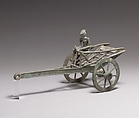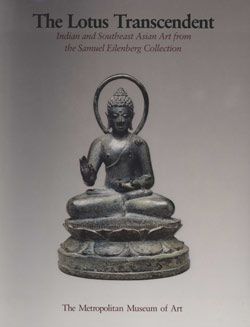Pull Toy of a Cart and Driver
Bronze and terracotta wheeled objects, probably intended to be children's toys, are found in many cultures—the early art of India, for example, is rich in such material. It is assumed that when made from the more costly bronze, the toys were for children of the upper classes.
Bronze toys with wheels and axles from the Eastern Javanese period usually take the form of horses and riders or rams and other animals. Representations of carts and drivers are uncommon but probably once existed in some numbers. In this example, the cart, faithfully reproduced from some original, is carefully modeled, but the driver is represented in a curiously cursory fashion. His dress and hairstyle indicate his humble origins, and his cap (or pigtail) and long pointed nose give him the look of a character from the Javanese shadow-puppet world. The significance of the short object in his right hand and of the longer one held in his left and extending beyond his elbows is unclear. The charm of the object is as apparent to us today as it must have been to its original owner.
Due to rights restrictions, this image cannot be enlarged, viewed at full screen, or downloaded.


